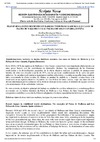Please use this identifier to cite or link to this item:
http://hdl.handle.net/10553/73855
| DC Field | Value | Language |
|---|---|---|
| dc.contributor.author | Domínguez Mujica, Josefina | en_US |
| dc.contributor.author | Gonzalez Perez, Jesus M. | en_US |
| dc.contributor.author | Parreño Castellano, Juan Manuel | en_US |
| dc.date.accessioned | 2020-07-28T14:29:22Z | - |
| dc.date.available | 2020-07-28T14:29:22Z | - |
| dc.date.issued | 2008 | en_US |
| dc.identifier.issn | 1138-9788 | en_US |
| dc.identifier.other | WoS | - |
| dc.identifier.uri | http://hdl.handle.net/10553/73855 | - |
| dc.description.abstract | Between 1950 and 1970, the capital cities of the islands of Mallorca and Gran Canaria concentrated an important tourist supply on some neighbourhoods which turned into outstanding destinations. The competition between the residential use and the geographical diversification of the accommodation supply has explained the decrease of tourist activities in these two cities since 1974, coinciding with the beginning of the new post-industrial age. Since then, the areas with more tourist supply have experienced important urban and social changes. In Palma de Mallorca, the tourist uses have lost ground respect to the residential uses, in an extremely deteriorated space. In Las Palmas de Gran Canaria, a more diverse situation emerges characterized by the coexistence of the substitution of lodgings for houses, the deterioration of some areas and the revaluation of the tourist activities.In this context, the principal aim of this contribution is to study the urban and socio-demographic changes happened in the tourist neighbourhoods of Palma de Mallorca and Las Palmas de Gran Canaria. The comparative analysis helps to reveal the different adjustment to the new tourist and residential specialization. | en_US |
| dc.description.abstract | Entre 1950 y 1970, las capitales de Mallorca y Gran Canaria concentraron una importante oferta turística en unos pocos barrios que las convirtieron en destacados destinos. La competencia de las funciones residenciales y la diversificación geográfica de la oferta alojativa explican la pérdida de protagonismo turístico de estas dos ciudades a partir de 1974, con las primeras manifestaciones de la nueva era post-industrial. Se suceden desde entonces importantes cambios urbanísticos y sociales en aquellas áreas donde se había concentrado la oferta turística. En Palma, se produce la pérdida de la función turística frente a la residencial en un espacio altamente degradado. En Las Palmas de Gran Canaria, surge una situación más diversa determinada por la sustitución de la oferta hotelera por la residencial, el deterioro de algunos sectores y la revalorización de las actividades turísticas. En este contexto, el objetivo principal del trabajo es estudiar los cambios urbanísticos y sociodemográficos acontecidos en los barrios turísticos de Palma de Mallorca y Las Palmas de Gran Canaria. El análisis comparativo contribuye a desvelar la diferente adaptación a la nueva especialización turística y residencial. | en_US |
| dc.language | spa | en_US |
| dc.relation.ispartof | Scripta Nova | en_US |
| dc.source | Scripta Nova-Revista Electronica De Geografia y Ciencias Sociales [ISSN 1138-9788],v. 12 (270) | en_US |
| dc.subject | 531290 Economía sectorial: turismo | en_US |
| dc.subject | 620103 Urbanismo | en_US |
| dc.subject.other | Established Tourist Destination | en_US |
| dc.subject.other | Immigration | en_US |
| dc.subject.other | Urban Renovation | en_US |
| dc.subject.other | Destinos turísticos maduros | en_US |
| dc.subject.other | Inmigración | en_US |
| dc.subject.other | Renovación urbana | en_US |
| dc.title | Transformaciones recientes en barrios turísticos maduros Los casos de Palma de Mallorca y Las Palmas de Gran Canaria, España | en_US |
| dc.title.alternative | Recent changes in established tourist destinations. The examples of Palma de Mallorca and Las Palmas de Gran Canaria, Spain | en_US |
| dc.type | info:eu-repo/semantics/Article | en_US |
| dc.type | Article | en_US |
| dc.identifier.isi | 000267809300092 | - |
| dc.identifier.issue | 270 | - |
| dc.relation.volume | 12 | en_US |
| dc.investigacion | Artes y Humanidades | en_US |
| dc.type2 | Artículo | en_US |
| dc.contributor.daisngid | 12430336 | - |
| dc.contributor.daisngid | 13267165 | - |
| dc.contributor.daisngid | 32219293 | - |
| dc.description.notas | http://www.ub.edu/geocrit/sn/sn-270/sn-270-93.htm | en_US |
| dc.description.numberofpages | 20 | en_US |
| dc.utils.revision | Sí | en_US |
| dc.contributor.wosstandard | WOS:Mujica, JD | - |
| dc.contributor.wosstandard | WOS:Perez, JMG | - |
| dc.contributor.wosstandard | WOS:Castellano, JMP | - |
| dc.date.coverdate | Agosto 2008 | en_US |
| dc.identifier.ulpgc | Sí | es |
| dc.description.jcr | 0,118 | |
| dc.description.jcrq | Q4 | |
| dc.description.ssci | SSCI | |
| item.grantfulltext | open | - |
| item.fulltext | Con texto completo | - |
| crisitem.author.dept | GIR IATEXT: Sociedades y Espacios Atlánticos | - |
| crisitem.author.dept | IU de Análisis y Aplicaciones Textuales | - |
| crisitem.author.dept | Departamento de Geografía | - |
| crisitem.author.dept | GIR IATEXT: Sociedades y Espacios Atlánticos | - |
| crisitem.author.dept | IU de Análisis y Aplicaciones Textuales | - |
| crisitem.author.dept | Departamento de Geografía | - |
| crisitem.author.orcid | 0000-0001-7460-5553 | - |
| crisitem.author.orcid | 0000-0002-1082-456X | - |
| crisitem.author.parentorg | IU de Análisis y Aplicaciones Textuales | - |
| crisitem.author.parentorg | IU de Análisis y Aplicaciones Textuales | - |
| crisitem.author.fullName | Domínguez Mujica, Josefina | - |
| crisitem.author.fullName | Parreño Castellano, Juan Manuel | - |
| Appears in Collections: | Artículos | |
WEB OF SCIENCETM
Citations
1
checked on Feb 25, 2024
Page view(s)
364
checked on Feb 8, 2025
Download(s)
211
checked on Feb 8, 2025
Google ScholarTM
Check
Share
Export metadata
Items in accedaCRIS are protected by copyright, with all rights reserved, unless otherwise indicated.
